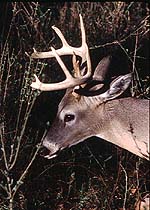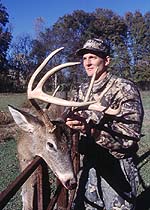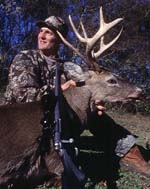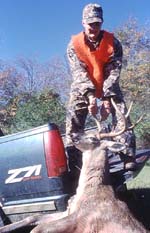
|
Features
|
|
|
|
Book Selections
|
|
Fun & Games
|
|
Contact Us
|
 BOB
WALKER EXPLAINS HOW TO KNOW YOU'RE TAKING THE DOMINANT BUCK
BOB
WALKER EXPLAINS HOW TO KNOW YOU'RE TAKING THE DOMINANT BUCK
EDITOR'S NOTE: Bob Walker of Livingston, Alabama, has studied deer carefully through the years, since he's grown up in the heart of deer country close to the Alabama/Mississippi border and gets to hunt deer for 3 ½ months each year. Call Walker or his wife, Alice, at R & J Meathouse, (205) 627-4295, and ask about their venison meatloaf mixture, which everyone raves about.
QUESTION: How do you know you're taking the dominant buck in an area during the rut? Too, when a nice 4-point, 6-point or 8-point comes by, how do you know which one to take or whether or not there's a bigger buck out there?
ANSWER: When a smaller buck approaches a scrape, he often will avoid it. He'll know where it is, but he'll go around it. A buck that's a little older, a 6-point or a small 8-point, may work a scrape. But if you watch him, he won't tear it up. He'll kind of just play with it, and every now and then he'll look over his shoulder. He'll be a little nervous. The dominant buck will have a certain look. He'll walk up to the scrape thinking, "This is mine." He'll thrash the limb above the scrape and throw dirt everywhere while working the scrape. You can look at a scrape and get an idea from the rubs how big the buck is.
 QUESTION:
What's your most effective tool to bag a big buck during the rut?
QUESTION:
What's your most effective tool to bag a big buck during the rut?
ANSWER: If I have enough room, I like to stay on the move. You've got to know the area and where the bucks are. I enjoy stalk hunting. I feel I can cover more ground by stalking. And I don't hunt like I will if I have a bow in my hand. I'm not going slow. I'm moving and covering a little ground. Usually by the rut, the leaves have settled, and there's more water in areas like little ditches. Plus, the area will be more open.
QUESTION: So you're moving in water, wading creeks and puddles and walking down woods roads with water in them?
 ANSWER:
Yes, and I particularly like to walk the edges of sloughs. You can ease
right down them without making any noise and often surprise deer.
ANSWER:
Yes, and I particularly like to walk the edges of sloughs. You can ease
right down them without making any noise and often surprise deer.
QUESTION: How far out are you trying to see the deer in front of you?
ANSWER: I like to see them at 100 yards. However, sometimes deer will surprise you. You may look over and spot a deer walking alongside you. I've done that a million times. You're looking everywhere but behind you or to the side of you, and then suddenly a buck joins in walking by you. By using water to hunt, you can hear the doe coming when the buck is chasing her, and you can hear the buck coming behind her. They'll usually run in circles when they're chasing each other. So, if you don't see them the first time, just stay in that area and wait for them to come back through.
 QUESTION:
How many times before have you had a buck pass by you?
QUESTION:
How many times before have you had a buck pass by you?
ANSWER: I've seen a buck chase the same doe across the same water about five times in 45 minutes or so before.
TOMORROW: BOB WALKER'S SECRETS TO STALK HUNTING DURING THE RUT
Check back each day this week for more from Bob Walker...
Day 1 - Hunting During The Rut
Day 2 - Walker's Favorite Equipment For Hunting
During The Rut
Day 3 - How To Know You're Taking The Dominant
Buck
Day 4 - Bob Walker's Secrets To Stalk Hunting
During The Rut
Day 5 - Rut Hunting Tactics That Produce Bucks